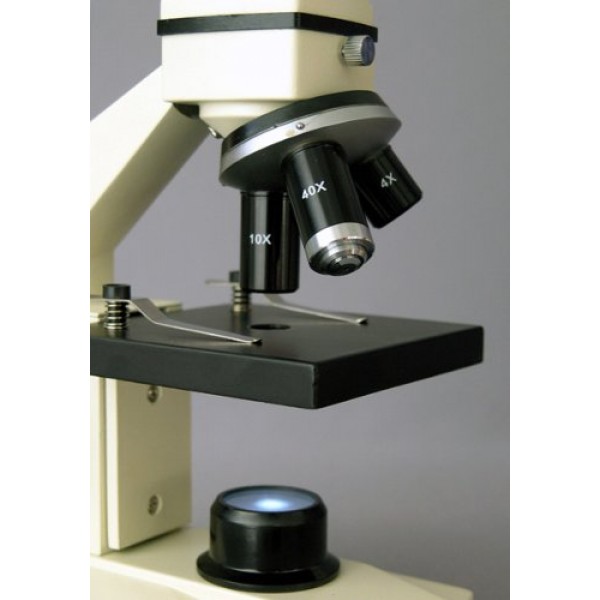AmScope M100 Compound Monocular Microscope, WF10x Eyepiece, 40x-40...
AmScope M100 Compound Monocular Microscope, WF10x Eyepiece, 40x-400x Magnification, Tungsten Illumination, Brightfield, Plain Stage
The AmScope M100 monocular compound microscope has one 10x widefield eyepiece, a forward-facing nosepiece with three DIN achromatic objectives, Brightfield tungsten (incandescent) illumination, a 0.65 NA single-lens condenser, and a plain stage. The forward-facing revolving nosepiece has 4x, 10x, and 40x DIN achromatic objectives that provide color correction of magnified images. The monocular viewing head has one WF10x eyepiece on a fixed 45-degree vertical inclination to reduce eye and neck strain and 360-degree rotation capability to provide a more comprehensive view and enable sharing. A compound microscope is used for inspection and dissection of specimens when two-dimensional images are desired.
The microscope has lower (diascopic) Brightfield illumination that transmits light up through the specimen for enhanced visibility of translucent and transparent objects. Brightfield (BF) illumination allows the specimen to absorb light, resulting in a dark image on a light background. Tungsten (incandescent) illumination provides bright light. The 0.65 NA single-lens condenser and disc diaphragm control the amount of light illuminating the specimen. The plain stage has an opening for light transmission and stage clips to secure the slide or specimen in place while viewing. A stage stop prevents the stage or specimen from coming into contact with the objectives. The solid-metal frame has a stain-resistant enamel finish for durability.
| Specifications | |
|---|---|
| Head | Compound monocular |
| Eyepieces | WF10x |
| Objectives | 4X, 10x, 40x achromatic |
| Stage | Plain |
| Lighting configuration | Transmitted (lower) |
| Condenser | Single lens |
| Diaphragm | Disc diaphragm |
| Light source | Tungsten (incandescent), 6W |
| Illumination type | Brightfield |
| Power | 110V/60Hz |
Microscopes are instruments used to enhance the resolution of an object or image. Types include compound, stereo, or digital. Compound microscopes use a compound optical system with an objective lens and an eyepiece. Stereo microscopes show object depth in a three-dimensional image. Digital microscopes are used to display an image on a monitor, rather than looking through a lens. Microscopes can have monocular (one), binocular (two), or trinocular (three) eyepieces, with varying magnification abilities. Magnification ability refers to the size of an image. Resolution, also known as resolvant power, refers to the clarity of the image. The interaction between field of view (FOV), numerical aperture (NA), and working distance (WD) determines resolution. Microscopes can control magnification through a fixed focus, or through a range of adjustments. They can also utilize LED, fluorescent, and mirror light sources to help control viewing capabilities. Microscopes are widely used in education, lab research, biology, metallurgy, engineering, chemistry, manufacturing, and in the medical, forensic science, and veterinary industries.
United Scope manufactures microscopy equipment and accessories under the brand name AmScope. The company, founded in 1996, is headquartered in Irvine, CA.
What's in the Box?
- AmScope M100 microscope with plain stage
- WF10x eyepiece
- 4x DIN achromatic objective
- 10x DIN achromatic objective
- 40x DIN achromatic objective
- (2) Stage clips
- Spare bulb
- Dust cover
- Instructions
- Compound microscope provides high magnification for biological use and educational applications
- Monocular viewing head with 10x widefield eyepiece, fixed 45-degree vertical inclination to reduce eye and neck strain, and 360-degree rotation capability to provide a more comprehensive view and enable sharing
- Forward-facing nosepiece with 4x, 10x, and 40x DIN achromatic objectives that provide color correction of magnified images
- Brightfield, tungsten (incandescent) illumination, and 0.65 NA single-lens condenser with disc diaphragm
- Plain stage with stage clips to secure slide and a stage stop to prevent damage to slides or objectives









